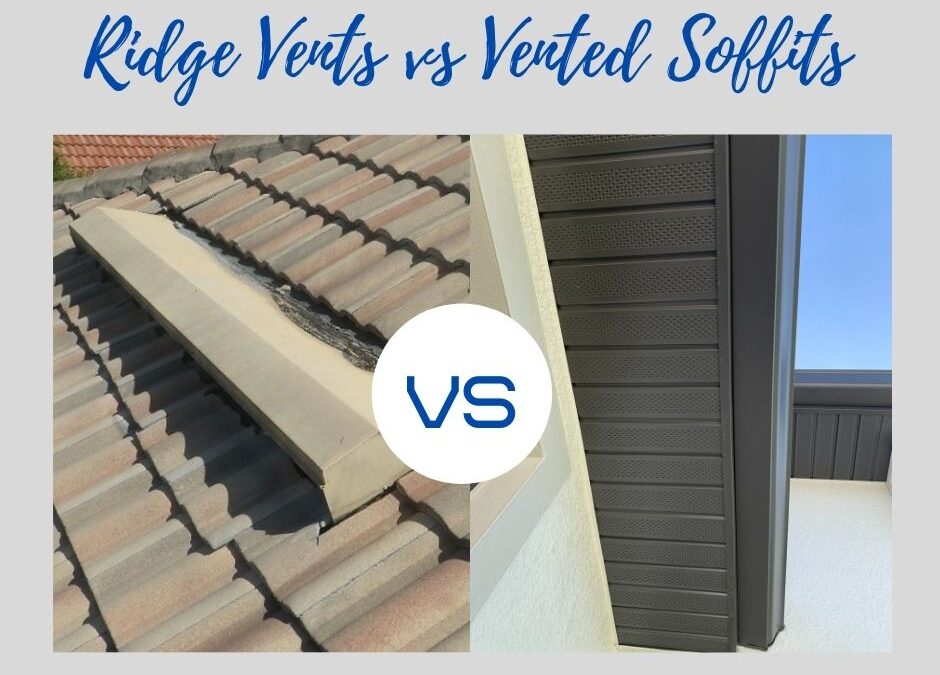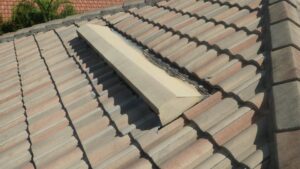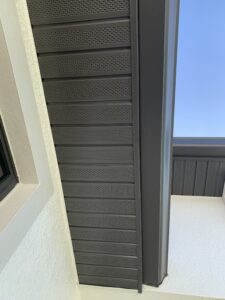When it comes to the ventilation of your roof, you have a few options. The most common ventilation options here in Florida are roof vents or soffit vents. The purpose for these options is to provide constant air flow through the attic space in your home. Properly designed air flow helps remove overheated air and moisture from the attic and roof system, which in turn prevents extreme temperature changes and moisture conditions occurring inside and outside of the home. Well-designed ventilation in your roof system is essential for proper heating and cooling.
Ridge Vents
Ridge vents were typically placed at the “ridge” of the roof, which is the highest point. Now, most builders in our area have adjusted to placing ridge vent about 2’ down off the ridge, as shown in the picture below.
These vents are designed to increase the airflow created by holes that penetrate the roof. The openings are then covered with a baffle to help deflect wind and rain. Ridge vents create a penetration into the roof and if are not installed properly homeowners can experience moisture issues, bowing of the vent and erosion of underlayment. Any time you penetrate the roof of the home you leave your roof open to potential leaks and moisture buildup.
Ridge vents are also not ideal for the heavy rain and winds of a hurricane. The wind driven rain can be forced through the vent into the attic, or worst case ripped off leaving access to the roof cavity with the potential for your roof to be lifted off the house.
With the problems that can arise using ridge vents, we feel the best method for proper roof ventilation is the use of vented soffits.
Vented Soffits
Vented soffits are installed into the underside of your home’s eaves or roof overhang. They run the entire perimeter of the roof line and have small holes that allow natural air flow to the attic. Soffit vents are designed to draw outside air up into the attic and with the use of insulation creates the proper air flow system to be pushed back out another area of vented soffits.
Because of their placement, soffit vents are more protected from wind and rain as well. Should any wind forced rain get up into the soffit, it would greatly be limited due to the small holes in the soffit. They also look more pleasing to the aesthetic of the home rather than a ridge vent coming out of your roof.
Insulation
A properly insulated attic eliminates the need for attic vents. Spray foam is the best option and helps tremendously in absorbing the heat and keeping your attic and home comfortable, as well as cooling costs down.
You can read all about spray foam insulation in our I Like My Roof with Foam blog.
Maintaining your Roof Ventilation System
Keeping your roof ventilation system free of any loose, cracked, broken or debris build up is key is ensuring the air flow is circulating properly. You should inspect your system every few months to look for these issues and make any repair immediately. Proper maintenance will help prolong the life of you roof and mitigate the potential for moisture issues or leaks.
Conclusion
When dealing with proper ventilation of your roof, soffit vents are much more proficient, less accessible to water getting into your attic with no roof penetration, and more aesthetically pleasing. When properly installed and routinely maintained, you will have an efficient ventilated roof system with less potential of leaks and moisture issues.



